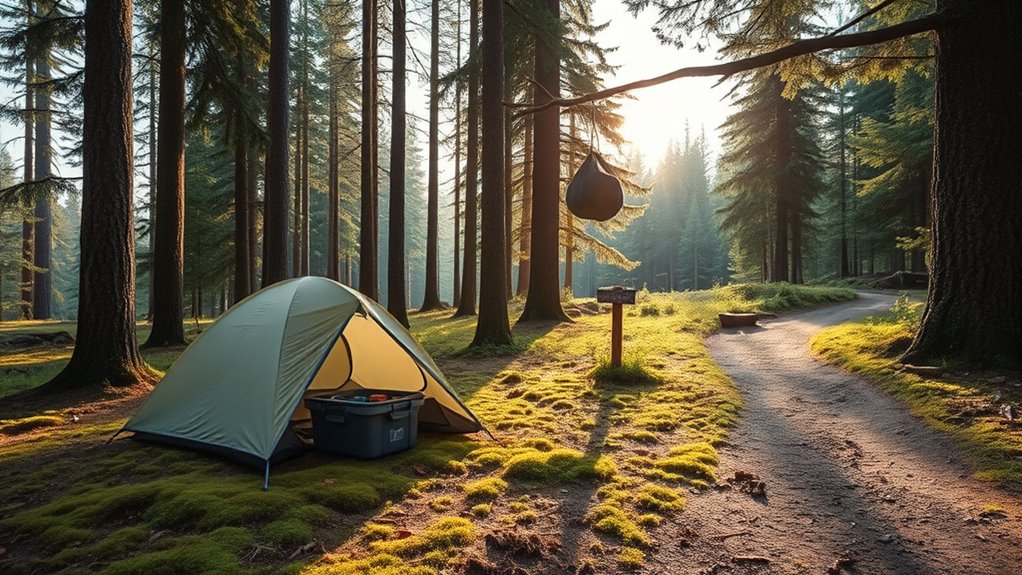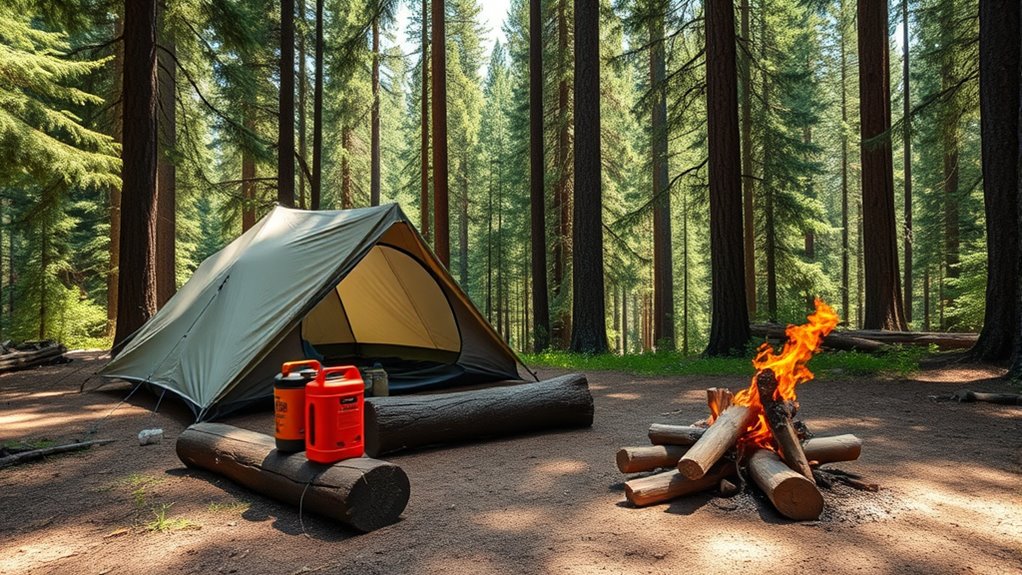To camp safely in bear country, choose spots away from trails, food sources, and thick brush. Store food securely in bear-proof containers or hang it at least 10 feet high and 4 feet from trees. Keep your campsite clean, dispose of trash properly, and avoid storing food near tents. Stay alert for signs of bears and respond calmly if you encounter one. Continue exploring how to set up your site to stay safe and protect nature.
Key Takeaways
- Choose a campsite away from bear trails, dense vegetation, and food sources with good drainage and flat terrain.
- Use bear-proof containers or hang food at least 10 feet high and 4 feet from tree trunks to prevent bear access.
- Keep tents and gear separate from food storage areas, and pack out all trash to reduce attractants.
- Recognize bear signs like growls or pawing, and use bear spray if a bear shows signs of aggression.
- Ensure all food and scented items are stored properly away from the campsite, and thoroughly extinguish campfires before leaving.
Choosing a Safe Campsite Location

When choosing a campsite, it’s essential to pick a location that minimizes your chances of encountering bears. Look for areas away from bear trails, animal food sources, and dense brush where bears might hide. Selecting a site with good drainage and flat terrain helps maintain campsite hygiene by preventing water pooling and reducing attractants. Keep an eye out for signs of recent bear activity nearby. Once you’ve settled, use food storage containers to keep smells contained, and avoid leaving food scraps around. Maintaining proper campsite hygiene is vital; always pack out trash, clean up thoroughly, and avoid leaving any food residues. A well-chosen, clean site considerably reduces the risk of attracting bears and keeps your camping experience safe. Additionally, being aware of bear behavior can help you recognize signs of their presence and respond appropriately.
Proper Food Storage Techniques

Proper food storage is essential for preventing bears from being attracted to your campsite. Use bear-proof containers to keep your food secure and inaccessible. These containers are designed to withstand bear attempts to open them, reducing the risk of attracting wildlife. When camping in bear country, you should also employ effective food hanging techniques. Hang your food at least 10 feet off the ground and 4 feet away from a tree trunk to prevent bears from reaching it. Use bear-resistant bags or sturdy cords and avoid storing food near your tent or sleeping area. Properly storing food minimizes odors and decreases the likelihood of bears noticing your campsite, helping keep both you and the wildlife safe. Additionally, employing proper storage techniques can further reduce scents and deter bears from approaching your campsite.
Setting Up Your Campsite to Minimize Wildlife Attraction

Setting up your campsite thoughtfully can make a significant difference in keeping wildlife at bay. Choose a location away from animal trails, food sources, and dense vegetation where animals might hide. Keep your tent and gear at a safe distance from your food storage area to reduce scent attraction. When hiking safety, stay alert and avoid leaving food scraps behind, which can draw curious wildlife. If you’re interested in wildlife photography, set up your camera discreetly and avoid flash that might attract animals. Clear the area of trash and avoid leaving cooking utensils or scented items outside. Proper campsite setup minimizes odors and food cues, helping you enjoy nature safely while respecting wildlife boundaries. Additionally, using appropriate food storage containers can further reduce the risk of attracting animals to your campsite.
Recognizing and Responding to Bear Encounters

Recognizing a bear encounter early can prevent dangerous situations from escalating. Stay alert to bear behavior: huffs, growls, or pawing indicate agitation, while a bear standing on hind legs may be curious. Use your bear deterrent, like bear spray, if the bear shows signs of aggression. Remember, your goal is to appear non-threatening and assertive. Being familiar with bear behavior cues can help you respond more effectively in these situations.
Tips for Packing Up and Leaving No Trace

After guaranteeing the bear has moved on or the encounter has ended safely, it’s time to pack up your campsite carefully. Start by collecting all food, trash, and scented items, storing them properly away from your site. Use bear-proof containers if available, and double-check that nothing is left behind. During wildlife photography sessions, be mindful of your surroundings, ensuring your gear doesn’t attract animals. When extinguishing your campfire, make sure it’s completely out, dousing it with water and stirring the ashes to prevent rekindling. Leave your campsite as you found it—clean, free of debris, and undisturbed. Following these steps helps protect wildlife, preserves the environment, and ensures you leave no trace, promoting safe and responsible camping for everyone. Additionally, practicing proper food storage reduces the likelihood of attracting bears and other wildlife to your campsite.
Frequently Asked Questions
How Can I Identify Bear Activity Signs at a Campsite?
To identify bear activity signs at your campsite, look for fresh bear footprints, which are large with five toes and visible claw marks. Check for scat, which can vary in appearance but often contains undigested food like berries or seeds. Also, watch for overturned rocks or logs, claw marks on trees, and broken branches. Recognizing these signs helps you stay alert and maintain safe distances from bears.
What Are the Best Bear-Resistant Containers Available?
Imagine your food safe behind a fortress with bear-proof locks, like a castle guarding treasures. The best bear-resistant containers are sturdy, made from durable materials, and feature bear-proof locks that can’t be easily tampered with. Always follow food storage regulations to guarantee your supplies stay secure. Brands like BearVault and IRONGLASS offer reliable options, making your campsite a fortress that keeps bears out and your food safe.
Are There Specific Foods That Attract Bears More Than Others?
Certain foods, like sugary snacks, canned goods, and strong-smelling items, attract bears more than others. To minimize this, practice food odor management by storing these items in bear-resistant containers and keeping them away from your campsite. Proper camping gear organization is vital; store all food and scented items in designated bear-proof containers, ideally hung or stored away from sleeping areas, to prevent attracting bears and guarantee a safe camping experience.
How Far Should Food Be Stored From Sleeping Areas?
Think of your campsite as a fortress, where proper food storage is your shield. You should store food at least 100 yards away from your sleeping areas, ideally in bear-proof containers or hung high and away from trees. Maintaining campsite hygiene by cleaning up crumbs and spills further keeps bears at bay. This distance and cleanliness create a clear boundary, helping protect you and preserving the natural balance of the wilderness.
What Should I Do if a Bear Gains Access to My Food?
If a bear gains access to your food, stay calm and don’t run. Use bear deterrent sprays if the bear approaches aggressively, aiming for its face. Create noise and wave your arms to deter it from staying. In an emergency bear encounter, back away slowly without turning your back, and leave the scene if the bear shows signs of aggression. Always report the incident to park authorities to prevent future encounters.
Conclusion
By following these bear-safe camping tips, you’ll create a campsite as invisible to wildlife as a whisper in the woods. Remember, your vigilance and respect for nature keep both you and the bears safe. Always store food properly, set up thoughtfully, and know how to react if you encounter a bear. With these practices, your adventure remains enjoyable and wildlife stays wild—just like a delicate dance where everyone stays safe and undisturbed.









